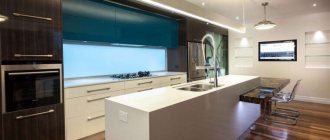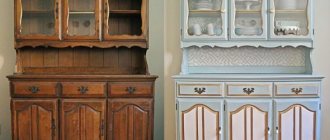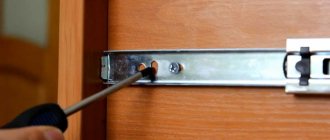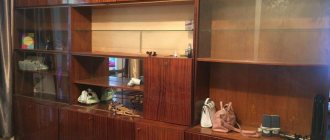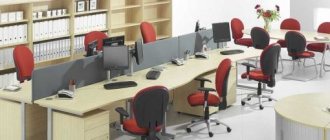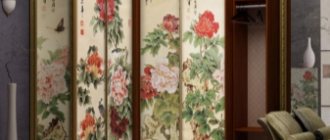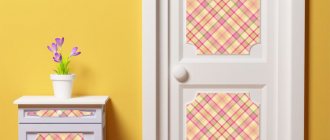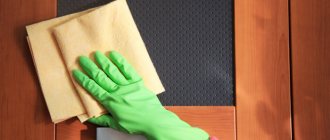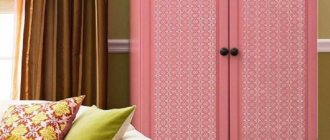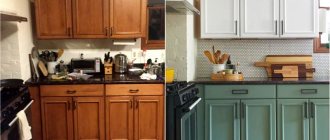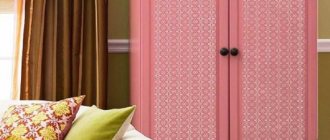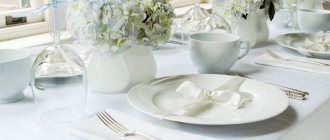Purchasing kitchen furniture is not cheap. Therefore, it is a shame when, after several years of operation, it loses its attractive appearance and problems appear in the functioning of its individual elements. It’s a shame to throw away old cabinets, bedside tables, tables and chairs, but buying new ones is expensive. Repairing kitchen furniture can not only extend the life of these items, but also significantly transform them, adding charm and originality.
Do it yourself or order furniture repairs at home?
Before you begin restoring kitchen furniture, you need to assess the amount of work and decide whether to do everything yourself or hire specialists.
Kitchen sets made from natural wood can be restored many times. Such furniture is not subject to significant deformation. Most often, wooden surfaces become covered with scratches, chips and abrasions during use. Eliminating these flaws with your own hands is possible even for a novice master.
It is more difficult with cabinet furniture made of MDF or chipboard with individual parts made of plastic, glass and metal. Remaking the body elements of bedside tables or cabinets that are swollen or have lost their geometry can be an overwhelming task, which means that the manufacture of new parts will have to be entrusted to specialists. But you can handle cosmetic repairs to the facade or countertop, adjusting or installing new hinges on the doors yourself.
Therefore, we have 2 ways:
- Carry out furniture repairs yourself. This option is suitable when you need to fix minor defects, you don’t need to make complex replacement parts, and also in a situation where you want to do without spending money. This path will allow you not only to save money, but also to bring your creative ideas to life.
- Contact a company offering furniture restoration services. This solution makes sense when damaged or lost-looking elements of the set cannot be repaired; a complete replacement of individual blocks, for example, facades and countertops, is required. In this case, you will have to spend money, but compared to buying new furniture, such a service will be inexpensive. The cost of replacing facades starts from 2200 rubles. per sq. m., countertops – from 4200 rub. per m.p.
During the repair process, it is useful to check and tighten all threaded connections: furniture assemblers often do not tighten them well enough, which leads to further loosening and distortion of the structure. And also lubricate all hinges and hinges to eliminate unpleasant creaking and ensure easy operation of these elements.
Our advantages
By ordering the required service from us, customers will receive inexpensive kitchen furniture repairs, as well as the following benefits:
- Quick departure. By filling out an application on the website or by phone, customers can be sure that the craftsmen will arrive on time. Clients can also set the exact time for specialists to arrive.
- Carrying out work at home. Kitchen furniture repairs are carried out at home, so customers do not have to overpay for the transportation of the furniture.
- Use of quality materials. During the work, our specialists replace outdated parts with new spare parts from leading manufacturers. Thanks to this, we guarantee a long service life of furniture after repairs.
- Registration of an official guarantee. We provide a long-term guarantee for all types of services. If during this period the client discovers a defect, our specialists will perform the restoration free of charge.
ContactsPriceDelivery
Depending on the size of the surface, replacement may take up to 8 hours of continuous operation.
Replacing one door is made to order, not done at the factory. Call a specialist Repair of kitchen facades
Manufacturing of kitchen facades
Door repair
A common defect in cabinet furniture is poor functioning of cabinet doors and bedside tables: they warp, do not want to close, and open spontaneously. The reasons are different: incorrect adjustment, defective hinges or magnetic latch, misalignment of the entire structure, swelling or delamination of the material.
Note: changes in the geometry of cabinets are often associated with the unsatisfactory condition of the back wall. The fiberboard sheet nailed there plays the role of a kind of retainer. If necessary, it is changed by cutting out the required fragment to size and attaching it with nails or small screws.
If the problem is in the loop, then replacing it is not always necessary: in most cases, adjustment helps. For this purpose, the design of the device has two screws: one is responsible for the fit of the door to the body, the second regulates its position in the frontal plane, moving it to the right or left.
A loop that has been torn out with meat can be put back in place using screws of a larger diameter. Another option is to drill holes, place wooden dowels in them using wood glue, and then screw fastening screws into them.
If the hinge breaks, it is replaced. Installation in old sockets is simple: mounting screws are screwed into the existing holes. It is more difficult if the hinge is installed in a new place or the door is changed. Assembly occurs in the following order:
- Sockets with a diameter of 35 mm for disc hinges are marked and cut with a milling cutter.
- A hinge plate is inserted into the slot located in the door perpendicular to the end and secured with a pair of self-tapping screws.
- The second plate is placed in the body, secured with screws through special holes in the bosses.
- Screw in the two adjusting screws to achieve the desired door position.
Details of adjusting the hinges are shown in the video.
Spontaneous opening of doors occurs when the magnetic strip is faulty. In some cases, it helps to clean the magnet and the iron plate it attracts from contamination, adjusting their relative position strictly opposite each other. If these measures do not help, then the element is changed.
And one more video: a little trick that will solve the problem of adjusting a cabinet with worn out hinges without replacing them.
Facade restoration
The most labor-intensive and troublesome type of repair is the restoration and renovation of the facade of kitchen furniture, the need for which arises after a certain time.
How is the varnished coating restored?
One of the most common ways to restore a damaged varnish layer is carried out in the following order. Minor damage is wiped with a cloth soaked in a mixture of alcohol and linseed oil (in equal proportions). After drying, the area is polished using cloth. For polishing, a mixture of GOI paste and kerosene is often used.
To restore kitchen furniture, you can use the decoupage technique.
In case of significant areas of varnish damage, the varnish coating is washed off using special emulsion compositions (SM-1, SM-2 and others). This solvent is applied to the entire surface of the panels, and after the varnish has softened, it is carefully removed with a spatula. After cleaning the surface, it is treated with a solvent and sanded with fine sandpaper. The dried surface is covered with new varnish.
Next comes painting.
Painting the kitchen facade significantly changes the entire style of the interior, so the paint color should be carefully thought out. Most often, combined painting is done: doors, sides and wall panels are painted in different colors. At the same time, harmony with the design of the kitchen walls should be ensured.
To carry out this type of restoration, all removable parts are dismantled: doors, wall panels, wall cabinets and fittings. The cabinets are disconnected from each other. The first stage is surface grinding, filling of significant defects, priming. Before painting, the surface is thoroughly sanded and degreased with a solvent. It is better to paint furniture using a spray gun or a can of aerosol paint for cars. You can also use a brush. Good quality is achieved when using acrylic enamels.
Sanding wooden elements
In many apartments there is wooden furniture, often inherited from grandparents. In terms of workmanship and artistic value, it is superior to a cabinet one, but over many years of service, the surface becomes covered with numerous scratches, chips and stains. The easiest way to make cosmetic repairs is sanding.
You will need the following tools: a scraper, sandpaper or a sander. The technique of using the scrapers is not difficult: the scraper is held with both hands and progressively moved in the direction of the wood grain. The disadvantages of rough grinding are eliminated with fine sandpaper.
The restored surface is treated with a primer. It will protect the wood from moisture and ensure good adhesion to the varnish coating. The varnish will add shine to the furniture and protect against the appearance of mold or mildew stains. It is applied similarly to paint, using a brush.
Facades
Restoration may be required not only due to breakdowns or other defects of the furniture, but due to its “moral” obsolescence. Having seen a design he likes, the owner may want to change the appearance of the facades. In this case, repairing a kitchen set involves updating its front panels.
Pasting with polyvinyl chloride film
PVC film is a popular material for redesigning kitchen furniture. It is easy to use, durable and does not fade. There are several types of film:
- smooth;
- with a textured surface imitating various natural materials;
- with embossing.
Imitations of wood and natural stone are the most impressive, not only in appearance, but also to the touch. The average film thickness is 0.2-0.55 mm.
It is advisable to paste kitchen facades and cabinets with a more durable and inexpensive material. It lays down easier and does not bubble during the sticking process. Since it is not easy to cover an old kitchen, it is better to follow the technique of gluing PVC film:
- Use a tape measure to measure the size of the façade. Leave 20 mm on each side for bending.
- On the back side of the film there is paper lined into squares measuring 10x10 mm. The obtained dimensions of the facade are marked on it. After which the fragment must be carefully cut out with a stationery knife or scissors.
- The fittings are removed from the kitchen facade: handles, hinges and locks are unscrewed. Working with PVC film requires an absolutely even base. Therefore, dirt and crumbs are carefully removed. The surface of the door is degreased using White Spirit or another solvent.
- Apply the film to the facade, not forgetting about the fold allowance. Gluing is carried out in the direction from top to bottom. Carefully peel off the paper base. Glue the film to the facade, ironing it with a dry cloth or sponge. Make sure that no air bubbles form. Gradually remove the paper, sliding it down. The greatest difficulty will be in processing the corners. To paste over an old kitchen, use a hairdryer. When heated, a slight heat-shrinking effect is obtained. In this case, the film is firmly attached to the base.
- The final stage of work is the installation of previously removed fittings.
Coloring
When thinking about how to make a new kitchen set from an old one, they remember the simplest and most affordable method: painting the facades. This method requires careful surface preparation.
- The doors are removed from their hinges and the fittings are unscrewed.
- Swollen or otherwise deformed ends are cleaned with sandpaper or an abrasive stone. Fine dust remaining after the process is carefully removed using a rag or vacuum cleaner.
- The facades are washed and degreased.
It is important to know: before painting, protect the workplace from splashes and drops by covering the surfaces with paper or cloth.
To transform facades, it is recommended to use spray enamels. The paint is applied holding the can at a distance of 15-20 cm. The door is installed vertically. You can also use the double coloring method using stencils. After the facades have dried, fittings are installed on them.
Rattan update
Rattan fabric is a beautiful material with a woven structure that has an easy-to-clean surface. When soaked in cool water for 15-20 minutes, it becomes soft and slightly increases in size. After drying, it becomes strong and elastic again. This property of rattan is used when redesigning furniture.
There are 2 options for updating facades. Using any of them, you can replace the glass of a cabinet and replace it with a dense, beautiful material with a textured surface.
- Making a frame from slats and attaching rattan to it with staples using a construction stapler. Work is performed with softened material. After drying, it will stretch and gain strength. The slatted frame is attached to the facade with small nails without heads or fixed with Moment glue.
- Glue dry rattan to the facade using water-based glue. A good choice is Moment Montage. A frame of slats is secured on top of the canvas with nails.
The slats are pre-polished and varnished. The most impressive are carved planks or those with a pattern burned into them. Instead of wooden ones, you can use metal or plastic slats.
Cosmetic repair of cabinet furniture
Small chips, abrasions or scratches can be eliminated by simple manipulations:
- The edges of the chips are trimmed with a chisel, after which the damage is filled with wax. When it hardens, the excess material is removed, the surface is sanded and painted over with a suitable felt-tip pen or a special furniture marker. A varnish applied over the top will protect the restored area.
If possible, it is better to buy furniture wax of the desired shade, which will help disguise any defects on the furniture.
- The procedure for repairing scratches is similar: a layer of wax, sanding, painting, applying a varnish coating. When using colored furniture wax, coloring is not required.
- Scuffs are painted over using a soft cloth onto which dye is applied from a felt-tip pen.
- The cracks are filled with PVA glue using a syringe with a thin needle, and then tightened with clamps.
The following video shows how you can easily mask chips on furniture made of chipboard using furniture wax chalk.
And this video shows the technology for repairing large chips on the surface of a tabletop using an enamel felt-tip pen, super-hard wax and acrylic varnish.
Main causes of failure
First, the user needs to identify the main causes of the breakdown. Often, the door of a chipboard cabinet cannot be torn out just like that. To do this, you need to make special efforts, and if the hinges fly out, they need to be urgently dismantled.
Reference! Inspect the scene of the accident to see if there is any damage to the cabinet in the form of material chips or scratches. If there are any, then you need to solve the problem of not only torn hinges, but also repair the cabinet itself.
Installation in this case is only possible if you have a number of repair tools.
The reasons for this incident may be:
- low-quality manufacturing materials;
- improper operation of furniture equipment;
- low mechanical strength characteristic of chipboard material;
Hinges are special panels that are attached to the cabinet. Fastening is carried out using self-tapping screws. This can also become a problem for repairs and cause breakdowns.
The fasteners themselves, presented in the form of self-tapping screws, hold up perfectly. But if, under mechanical stress, the cabinet door gives way and the fastening element falls off, it can take with it part of the material from which the door itself is made.
Don't miss: How to paint interior doors with your own hands?
Of course, this becomes a problem, because now you can’t screw the screws into their original place. How then to install the cabinet door?
Replacing the end edge
A common occurrence is a peeling end edge. Having found an edge that matches the color, prepare the tools necessary for repair: scissors, iron, painting knife. To smooth it you will need a roller or cloth.
- Cut the workpieces with allowances of 1–2 cm in length.
- With the tabletop facing up, apply the edge and smooth it with an iron. The heat will melt the glue.
- The glued workpiece is pressed to the end and smoothed with a cloth or a piece of felt, directing the movements along.
- Excess edges are removed using scissors and a carpenter's knife.
- The joints at the corners are sanded with fine sandpaper.
Restoration of kitchen facades from MDF
Small chips and scratches are repaired with a furniture wax pencil. It is applied to the damaged area, and after hardening, the restored surface is sanded with fine sandpaper. The pencil is selected to match the color of the facade.
USEFUL INFORMATION: Siphon for connecting a dishwasher
Decorative stickers will update the look of the headset and hide minor defects. Before gluing them, the surface is cleaned and degreased.
In case of more serious damage, it is necessary to completely change the appearance of the furniture. For kitchen facades made of MDF, painting or covering with vinyl film is suitable.
Facade repair
The front parts of kitchen units most often need updating. There are many options: restoration of the old coating, painting, using self-adhesive film, decoupage. If desired, you can give the furniture a completely new, unique and original look.
How to update kitchen furniture
When updating a kitchen set, you need to focus attention not only on the cabinets and their facades, since other items also become unusable from long-term use - handles become loose, the coating peels off, the lining is worn out. But, if necessary, restoration of this furniture can be carried out by analogy with facade surfaces. You can repair and update the appearance with your own hands for the following units:
- chairs;
- countertops;
- kitchen tables.
If you approach this issue correctly, the restoration procedure does not cause any particular difficulties, and the final result will be no worse than design developments. Ideas for modifying and decorating pieces of furniture can also be gleaned from designer master classes or using your own imagination and attention to detail.
Tabletop
The countertop in the kitchen, as the main work surface, is constantly exposed to negative influences during the cooking process. Such factors lead to destruction of the surface and the appearance of scratches, stains, holes and other types of damage. To update the kitchen countertop, replace the surface with a new one, for example, made of artificial marble or porcelain stoneware. If you are restoring a work surface with your own hands, then you often take into consideration the option of ceramic tiles:
- The surface must be leveled with a sharp tool, for example a knife, cutting off all swollen or deformed areas.
- A metal profile of small height is fixed along the perimeter of the plane as a side for placing tiles.
- The glue is applied directly to the degreased surface of the table, this will enhance adhesion and fix the new coating more firmly.
- The tiles or fragments are laid tightly so as not to leave gaps, leveling the surface.
- When the tile surface has already been assembled, you need to fill the seams with epoxy and level the resulting coating.
Attention!
After hardening, epoxy resin acquires a dense structure, this will preserve the condition of the surface for a long period. This composition, after removal, does not pose any health hazard, so it is used as a coating in the manufacture of bar counters or tables in cafeterias.
Chairs
Chairs, like stools, are among the most common units of kitchen furniture, especially when the kitchen is combined with a dining room. The seats that are most susceptible to wear and tear require replacement of the filling and upholstery. Of course, scuffs or tears can be hidden under specially sewn covers, but this approach will not correct the deformation of the filler. Repairing a chair involves the following algorithm:
- Removing the old trim - usually on the reverse side there are simple fastenings of the seat to the frame and clips holding the material.
- If the filler is completely unsuitable, you should simply throw it away after disassembling the seat.
- The base must be cleaned of any remnants of old filler and, if necessary, leveled (wetting with water and pressing with a weight until completely dry).
- It is recommended to clean the frame from the old coating by sanding, and then cover it with varnish or paint.
- New material is cut out using a template from the old one. After placing fresh filler, it is fixed to the base with a construction stapler.
The fabric for seat upholstery must be durable and non-marking. Depending on the intended style, they buy material of a neutral tone and sew ordinary covers. It is worth abandoning options with leatherette, since this type of covering is short-lived and, with minor damage, will quickly spread into long tears, which is why you will need to perform the entire updating procedure again.
Cabinets
Of the kitchen furniture, cabinets suffer the least during use, since the use of these parts of the kitchen furniture is not widespread. But, cabinets sometimes also require restoration. The weak points of this kitchen unit are the legs, doors, and shelves. Often the entire body becomes loose. To restore a cabinet in the kitchen with your own hands, perform the following types of repairs:
- Replacing legs. New support parts can be purchased at a hardware or furniture store. To replace a piece of furniture, turn it over, remove the old legs and screw in new ones. If the previous fastening points are very loose, it is recommended to fill the holes and screw the screws into new places.
- If the housing becomes loose, you need to check the condition of the fasteners. When the bolts or screws are loose, just tighten them, then everything will be fine. If the attachment points are damaged, buy corners of the appropriate size, and then fix them in new places to strengthen the body.
- Drawer guides and bottoms suffer. These elements must be completely replaced with new ones - the fittings are purchased at a hardware store and fixed in new points. You can try to level the bottom, but usually this method does not allow you to completely restore it - it’s easier to cut it out or order a new one.
- Shelf fastenings that have come loose and are lost are replaced with new fittings. If the previous places are broken, you need to fill the chips and fix the fittings on the entire part of the wall. Shelves are also replaced when broken - they can be cut out yourself or ordered from a furniture workshop.
Attention!
The doors act as the front part of the kitchen - such parts of the kitchen unit are restored in the general manner - sanding, painting, drawing and replacing fittings. The front panels of the bedside tables can also be completely replaced with others.
Kitchen table
A table located in the kitchen also requires restoration after prolonged use - its legs may become loose and the surface of the tabletop may be damaged. In the case of the legs, they need to be tightened more tightly, which requires a screwdriver, wrench, hexagon or pliers, depending on the structure of the fastener. To restore the countertop, you can lay ceramic tiles or paint with acrylic. For stencil painting you need:
- paint of the required colors;
- brushes with long bristles;
- stencil with the intended pattern;
- foam sponge.
The main tone is applied to a cleaned, sanded surface in 2-3 layers to obtain an even tone. After the initial table covering has completely hardened, you should apply the stencil in the right places and apply a different color with a sponge, ensuring that the edges are blurred. When the design has dried, you can coat the surface with a polyurethane-based varnish, which will ensure the durability of the design, as well as the smoothness of the table.
Repair with self-adhesive film
The self-adhesive film will give the headset a unique appearance.
Repairing facades using film is simple:
- The surface is prepared: the fittings are removed, the facade is sanded, degreased and primed.
- A piece of film is cut with an allowance of 2 cm on each side.
- The protective layer is removed from an area of 10–15 cm, the film is glued to the edge and at the same time smoothed with a piece of fabric.
- Next, gradually unwinding the roll, you need to fix the entire fragment on the facade, avoiding, if possible, the appearance of air bubbles.
- When pasting the ends and rounded areas, it is recommended to slightly heat the film with a hairdryer to make it more elastic.
- If it was not possible to avoid their formation, the bubbles are pierced with a needle or carefully cut to allow air to escape. All that remains is to smooth out the film.
- Excess material is carefully trimmed.
More details in the video.
The use of self-adhesive film during renovation often completely transforms kitchen furniture.
Application of film and plastic
A fairly simple method of restoration is the use of self-adhesive film. Before gluing it, it is necessary to treat the surface with a solvent to remove dirt and grease. There should be no obvious dents or bumps on the surface: all such defects will appear through the film. Smoothing is done using a rubber squeegee or spatula. If air bubbles appear, they should be carefully pierced with a needle or cut with a razor and smoothed out.
Renewing the facade using sheet plastic does not require sealing surface defects, since they are covered with a sheet of sufficient thickness. The plastic is cut to size and glued using special glue. The edges of the sheet are carefully processed with a file to form a small chamfer.
Nowadays, most furniture, such as cabinets, bedside tables, kitchens, and so on, are made of chipboard. The material is good, quite flexible (there is one for every taste and color). However, it has a big disadvantage. Over time, especially if this is a frequently used door, the hinges can be pulled out by the roots (probably many have experienced this), and the hinge dangles... the sash sags, or even comes off altogether. In general, how can I fix this whole thing? Detailed instructions + video version...
The essence of the problem is that it will not be possible to screw the “screws” back into these torn fasteners. They simply won’t stay there. We need to fix it some other way. For me personally there are only three. I’ll tell you about each one separately.
Removing old film from furniture
A small peeling of the old self-adhesive film can be eliminated using PVA glue. The hardest part is getting to every hard-to-reach place.
But with large-scale damage you will have to do something radical: remove the film layer completely. This is done as follows:
- All fittings are removed. For convenience, it is worth dismantling the facade parts and working with them in comfortable conditions.
- The film is heated with a hair dryer, then removed with gloved hands.
- The surface is cleaned of glue residues, degreased, and then ready for further finishing: gluing a new layer of film or painting.
Furniture painting
It is often easier to paint the facade than to restore the old varnish coating. At the same time, you can radically change the design of your kitchen.
Proper painting includes the following operations:
- Disassembling the headset: removing fittings, hinges and drawers.
- Surface preparation: cleaning from dirt, grinding, removing dust, degreasing, priming. The latter is performed several times with breaks of 6–8 hours: this will reliably protect the material from external influences and ensure high paint adhesion.
If you plan to paint in different colors, the part of the surface on which a different shade will be applied is covered with masking tape. The same applies to elements that need to be protected from paint during the repair process.
It is best to paint using aerosol cans or a spray gun: this way it is easier to ensure uniform color and no streaks from a brush or marks from a roller will be visible.
Repair of kitchen facades in the company Apriorimaster
Repairing paint chips, scratches and other damage to your kitchen façade yourself is not easy if you've never done it before. It’s not just about screwing in a light bulb or hammering a nail into a wall – it requires knowledge about the properties of materials and the peculiarities of furniture production.
So, when repairing wooden kitchen facades, you need to carefully select the coloring layer and type of varnish so that the repaired area is invisible. Often kitchen elements made of natural wood become deformed - then reconstruction or replacement of the element will be necessary.
It is impossible to find a suitable door in a store; you need to order it from a woodworker. Any elements of kitchen facades in Moscow are always in stock and can be ordered in our workshop!
Decoupage
This technique is a kind of appliqué made from various materials. Most often they use drawings cut out from napkins or magazines.
It is recommended to layer the paper so that the applique protrudes less above the general level of the facade. The further algorithm of actions is as follows:
- We prepare the surface: remove handles and other fittings, clean the paintwork, sand and repair defects.
- To achieve transparency of the varnish layer, mix white acrylic varnish and white paint.
- We paint the background in the direction of the wood grain.
- We place the prepared pattern, cut out and thinned, symmetrically relative to the facade and cover it with a layer of PVA.
- After letting the glue dry, we treat the surface with fine sandpaper, after which we apply a transparent varnish composition.
- After sanding the dried varnish, apply a new layer. And so on until the desired result is obtained.
A detailed master class on decoupage of furniture from chipboard is in the next video.
Another option for decoupage is the formation of ornaments using putty:
- Mix PVA glue and oil putty until the consistency of thick sour cream.
- We make a stencil of the future design from thick paper or cardboard.
- We fix the stencil on the facade, then apply the prepared solution with a spatula.
- After drying, we sand the ornament and coat it with varnish: first transparent, and then matte.
Decoupage can transform the most unattractive furniture. There are a great many options for the materials and technologies used. It all depends on the imagination and artistic taste of the master.
Types of kitchen facades and their features
The façade design is a base covered with a decorative coating. The performance characteristics depend on the base part; the finishing protects the base and decorates the product. The front side of the kitchen unit is responsible for the overall appearance of the interior of the room. There are many varieties of these elements, which according to their structure are divided into two basic types:
- Frame. They are a combination of two materials, one of them fills the middle of the canvas, the second serves as a frame.
- Solid. The cabinet doors are a solid plate without seams or joints.
According to the method of opening doors, they are divided into:
- swing;
- folding;
- with lifting mechanism;
- sliding
Base material:
- Chipboard. The most budget option. It has good resistance to mechanical stress, but is inferior in appearance to other building materials.
- MDF. It has good strength characteristics, is used in the manufacture of curved structures, and has a smooth surface.
- Natural wood. Traditional raw materials used in the production of most models previously had no alternatives. This is the most expensive and high-quality product with a beautiful natural pattern.
- Glass. Mostly triplex or hardened versions are used in production. Can be transparent or matte. The ends are edged with an aluminum frame.
- Metal. There are models made of stainless steel and aluminum. They are characterized by durability and resistance to moisture.
Cover type:
- Enamel. Products are coated with special varnishes and paints.
- Plastic. Used for chipboard and MDF panels. Does not scratch, does not fade, is not afraid of moisture or chemicals.
- PVC films. They increase characteristics such as resistance to mechanical damage, high temperatures, and sunlight.
- Veneer. It is durable and enhances furniture.
Restoration of countertops made of chipboard or wood
Areas of the tabletop that are swollen from moisture or chipped are quite easy to restore. The repair procedure will be as follows:
- Remove loose pieces of material.
- Thoroughly dry and sand the surface.
- Mix PVA glue with sawdust to form a thick mass.
- Fill the indentations with the resulting mixture, place the weight and leave for 24 hours.
- We apply a protective coating to the surface.
Restoring a burnt countertop
Such damage is not uncommon for the surface of kitchen cabinets and tables. Replacing the countertop is a radical measure, but you can try to do without it by eliminating the damage yourself.
- Using a pencil, outline the boundaries of the defect with an allowance of 2 cm onto the undamaged surface.
- We remove the burnt area of the chipboard. A router is used for this operation. They sequentially remove layers of material: first along the intended line to one depth, then using a longer cutter to remove the next layer. And so on until the defective material is completely removed. The result is a stepped depression that looks like a miniature diamond and coal mine.
- Using a router, we make teeth along the contour of the cutout for better adhesion of the patch material to the base. This will also help make the transition smoother.
- Fill the hole with wood putty. We cut off a piece of the required size, knead it with our hands until soft and carefully compact it into the cutout. You need to work quickly, as the putty dries in a matter of minutes.
- We remove excess material protruding beyond the plane of the tabletop with a tool with a smooth edge. Some craftsmen use an old plastic card for this. To speed up the process, use a milling cutter with special grinding attachments.
- We polish the smooth surface using GOI paste with a soft-coated nozzle. This will add shine to the patch.
- All that remains is to paint the area to be restored, repeating the color and texture of the main part of the tabletop.
Replacement of accessories
Furniture must function correctly, so replacing fittings is an important process in restoration.
Replacing fasteners and handles
New pens
One of the easiest jobs in this area is changing handles. If you put new, beautiful handles on your kitchen set instead of old ones, then the furniture will be slightly updated and will become more aesthetically pleasing. But provided that a new set of fittings is installed on all cabinets of the same model.
When choosing, pay attention to the design and material of the handles. For furniture made of fiberboard, plastic elements will look ridiculous. Models combined from different materials, for example, metal with wood or with glass inserts, will look impressive. The main thing is that in the end all the details are in harmony with each other. Also don't forget about comfort.
Replacing hinges
Loose, old fasteners, warped doors, and the furniture already looks untidy. Install new hinges. Just when installing, do not try to fix them into the same holes, especially if the inside of the headset is made of cheap material. It is advisable to move the door hinges to a new location.
The work is not very labor intensive in several stages:
- We dismantle the old hinges.
- When making markings for new fastenings, if the doors are paired, try to ensure that the metal structures are on the same level.
- We drill holes.
- We install new fasteners.
The whole procedure will not take much time. Old holes will need to be filled with putty. You will need to purchase putty for woodwork, apply several layers, and then paint over these places.
Making a tile countertop
What to do if the countertop is swollen or warped from moisture? The easiest option is to replace it with a new one, but there is no guarantee that it will not share the fate of the old one. Tile coating is more reliable, and it is not difficult to carry out such modernization of a kitchen set.
Tile countertop Do-it-yourself tile countertop Kitchen table with a tiled surface Tabletop and backsplash made of the same tile
Work order:
- The basis of the new countertop is made up of sheets of expanded polystyrene, fixed with liquid nails.
- Protective elements are attached to the same composition. Metal skirting boards are best suited for these purposes: corner ones, connecting the surface of the tabletop and the wall, end and thin ones, serving as edging for the tiles.
- Tile adhesive is applied to the new base surface of the countertop.
- The tiles are being laid out. Its height should correspond to the thin baseboards around the perimeter of the tabletop.
- After the glue has dried, the joints are grouted. It is recommended to use silicone-based waterproof compounds. This will prevent moisture from entering the structure.
The result is a smooth and durable surface that is not afraid of water.
Prices for individual repair work
| Type of work | Price |
| Primer of walls | 67 RUR/m² |
| Plastering walls | from 313 RUR/m² |
| Wall putty | from 207 RUR/m² |
| Plastering walls for painting | 387 RUR/m² |
| Installation of partitions from gypsum plasterboard | from 633 RUR/m² |
| Installation of gypsum board ceilings | from 663 RUR/m² |
| Cabling | 56 rub/m/p |
| Installation of heated floors | 884 RUR/m² |
| Naslit linoleum | 178 RUR/m2 |
| Laying tiles | from 782 RUR/m² |
| Installation of self-leveling floors | 310 RUR/m² |
| Screed device | from 608 RUR/m² |
| Electric point installation | from 332 RUR/piece |
| Installation of lamp, chandelier | from 387 RUR/piece |
| Tiling "apron" (grouting and trimming) | 1725 RUR/m2 |
| Kitchen sink installation | 884 RUR/piece |
| Wall painting | 178 RUR/m² |
| Wallpapering walls | from 221 RUR/m² |
| Ceiling painting | 199 RUR/m² |
| Wallpapering the ceiling | 276 RUR/m2 |
| Installation of ceiling plinth | 166 RUR/m |
What facing materials should I choose?
Many experts recommend choosing tiles as the main facing material for the kitchen. It has increased strength, wear resistance, and moisture resistance. The tiles are easy to clean with any detergent or plain water. It is produced by multiple manufacturers and can have almost any color, texture, or size. Also, if the client wishes, other materials can be used for finishing – putty, paint, decorative plaster, laminate, etc.
Chair repair
Damaged coverings of old kitchen chairs can be restored using the above methods. The exception is furniture with soft seats: re-upholstering them without skill is quite problematic, although possible. But there is a simple option: make a cover. In this case, reupholstery will not be required, and the appearance problem will be solved.
Loose parts are strengthened using wood glue. In exceptional cases, self-tapping screws are used with mandatory drilling of holes for them. Painting and decoupage transform an old, unsightly chair into an original and beautiful piece of furniture.
You should not throw away old kitchen furniture that has lost its outer luster. With a little imagination, you can give it a completely new appearance, adding originality to the interior of your home.
